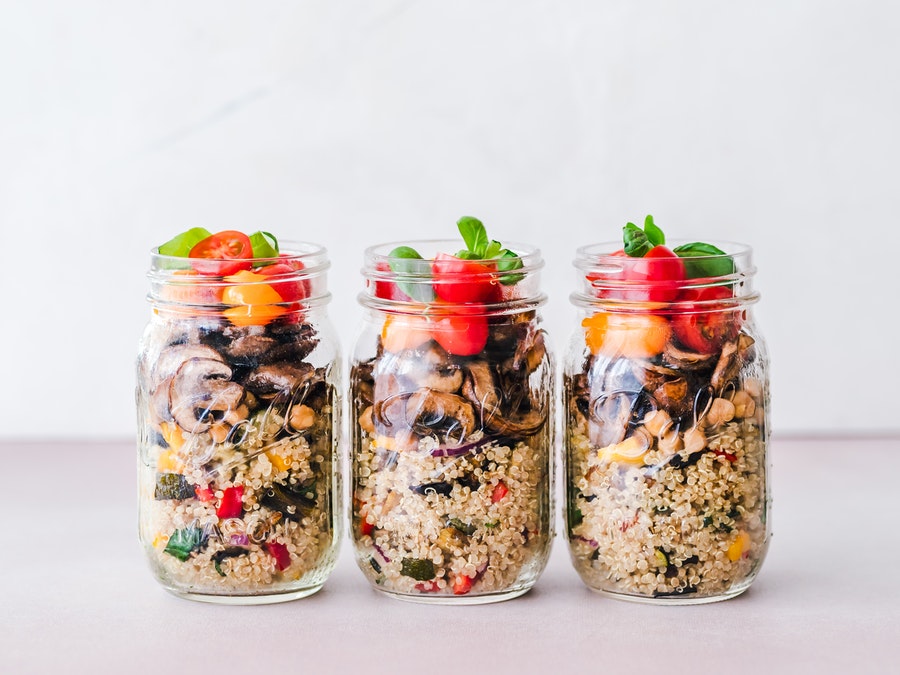
The reality of inflation didn’t really hit me until I recently found myself standing in the grocery store staring at green onions. A small bunch of these veggies, which I’m used to paying $0.50 for, were suddenly $2. Yowza!
I’m sure I’m not the only one who’s noticed groceries taking a bigger bite out of my wallet lately. In fact, economics experts are predicting rising food costs for at least the next couple of years. Whether pricier provisions have you scrambling to feed your family or you’d just like to pare down on impulse buys for yourself, spending a little less on groceries probably isn’t a bad idea.
As a nutritionist, I’ve learned a few things about how to stretch a food budget and still eat well. Here are my top five tips.
1. Make time for meal planning
For eating right in the real world, this is probably my most oft-repeated mantra: meal plan, meal plan, meal plan. Plotting out your week’s meals puts you in control so you know exactly which ingredients you want to purchase—and which you can leave behind. Besides that, it saves you time (no wandering around the grocery store hoping inspiration strikes) and even helps you eat healthier. (Trust me, it’s science!)
I set aside time every Sunday afternoon to plan my family’s meals. With the help of some favorite cookbooks, food blogs, and Pinterest, I can craft a whole week’s worth of dinners in a relatively brief window. And if saving money is your goal, there’s no need to stop at dinner—planning breakfasts, lunches, and even snacks can narrow down your necessities so you don’t overdo it while shopping.
2. Let plants play a bigger role in your meals
Plant-based eating isn’t just trendy. It’s also a near-guarantee for cutting grocery costs. You don’t need a math degree to realize that, by and large, plants are cheaper than most animal products like meats and dairy. Especially when you buy produce in season, you’re likely to find low prices. One survey found that vegetarians spent an average of $23 less on groceries than meat-eaters each week.
The key, of course, to plant-based eating that won’t break the bank is to make (rather than purchase) much of your own food using inexpensive, whole ingredients. Springing for pricey faux meats or vegan cheeses can add up fast, so consider how you might whip up your own DIY bean burgers or cauliflower buffalo wings.
3. Buy in bulk
We’ve all probably experienced what I like to call PCRS (Post-Costco Regret Syndrome). If you’ve ever asked yourself how on earth you’re going to use 70 eggs and nine loaves of bread before they go bad, you know that buying in bulk isn’t always a smart bet for saving on food costs.
Still, done right, bulk buying can be budget-friendly. Here’s how: Give some thought to which items you use frequently — as in, every week. Then make those your go-to bulk foods. Alternatively, if you’re willing to put in some extra time, purchase larger, discounted amounts of foods you know you can save by freezing, canning, or drying. My favorite strategy is to buy inexpensive berries in season and freeze them to use in the months to come.
4. Get familiar with low-cost recipe substitutions
Imported Alpine cheese in fondue? Fleur de sel on brownies? I’m a devout foodie, but ain’t nobody got time (or money) for that! Still, since I enjoy cooking, I don’t like to forgo making something delicious because its ingredient list is too high-end. Instead, I try to think of recipes with expensive ingredients as an opportunity to get creative. Often, sea salt will do just as well as anything flaky and French, for example, and Swiss cheese is almost indistinguishable from gruyere. Instant money saved!
Even when ingredients aren’t particularly pricey, simply loading up on too many of them can also add to your grocery bill. When whittling down your food budget, try focusing on five-ingredient-or-less meals. Entire cookbooks have been written with this goal, and Allrecipes.com even has a page devoted to them.
5. Love on leftovers
Often, money lost on groceries comes down to money lost on uneaten food. We Americans have a bad habit of wasting a shocking 40% of our food supply. A weekly leftover night could put a small dent in this figure (and good-sized a dent in your grocery spending). You may be surprised at how far leftovers go. A bit of cooked pasta could be the base of a soup, leftover meats can find their way into tacos, and extra rice makes a mean next-day fried rice.
In my family, it seems like there’s always something hanging around the back of the fridge that can serve as part — or all — of a meal.
Originally published on September 28, 2021.